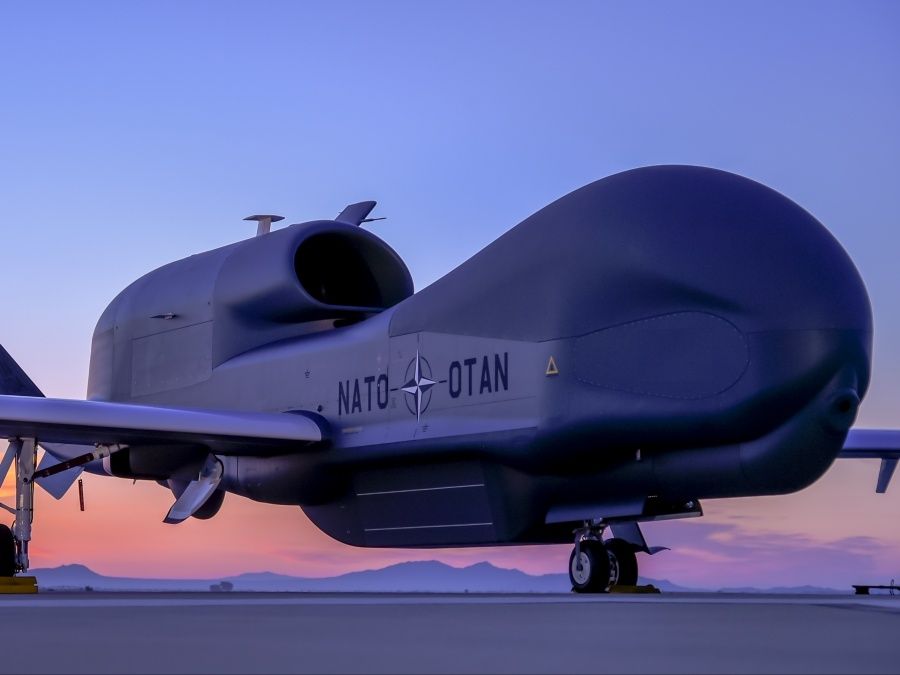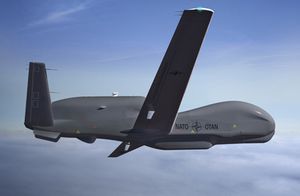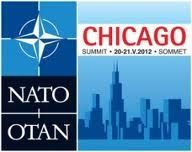21/05/2012 OTAN Organisation du Traité de l'Atlantique Nord
1.En tant que dirigeants de l'Alliance, nous sommes résolus à faire en sorte que l'OTAN conserve et développe les capacités qui lui sont nécessaires pour exécuter ses tâches fondamentales essentielles - défense collective, gestion de crise et sécurité coopérative - et, partant, pour jouer un rôle clé dans la promotion de la sécurité dans le monde. Nous devons assumer cette responsabilité alors que nous sommes aux prises avec une crise financière grave et que nous sommes confrontés à des défis géostratégiques en constante évolution. L'OTAN nous permet d'assurer un niveau de sécurité plus élevé que celui que pourrait atteindre un Allié qui agirait isolément. Nous réaffirmons l'importance que continuent d'avoir un lien transatlantique fort et la solidarité au sein de l'Alliance, ainsi que l'importance d'un partage des responsabilités, des rôles et des risques pour permettre aux Alliés nord-américains et européens de relever ensemble les défis auxquels ils sont confrontés. Nous reconnaissons l'importance d'une défense européenne plus forte et plus performante, et nous saluons les efforts déployés par l'Union européenne pour renforcer ses capacités à faire face aux défis de sécurité communs. Ces efforts constituent, par leur nature même, une contribution importante au lien transatlantique.
2.Le potentiel de l'OTAN réside dans les forces de ses pays membres - leur entraînement, leurs équipements, leur interopérabilité et leur expérience - rassemblées sous la structure de commandement intégrée qui est la nôtre et dirigées par cette dernière. Les succès que nos forces ont remportés en Libye, en Afghanistan, dans les Balkans et dans la lutte contre la piraterie sont autant d'exemples évidents de ce que l'OTAN demeure inégalée dans son aptitude à déployer et à maintenir une puissance militaire afin de sauvegarder la sécurité de nos populations et de contribuer à la paix et à la sécurité internationales.
3.Ces succès sont le résultat de plus de soixante années d'étroite coopération dans le domaine de la défense. En oeuvrant ensemble au sein de l'OTAN, nous sommes mieux en mesure d'assurer la sécurité de nos concitoyens - et avec bien plus d'efficacité et d'efficience - que nous ne pourrions le faire en agissant isolément.
4.Nous avons déjà accompli des progrès concrets depuis notre dernier sommet et l'adoption d'un nouveau concept stratégique, à Lisbonne, pour veiller à ce que l'OTAN dispose des capacités dont elle a besoin pour défendre les citoyens de ses pays, pour mener des opérations de gestion de crise et pour promouvoir la sécurité coopérative. Entre autres réalisations importantes :
nous avons aujourd'hui déclaré une capacité intérimaire de défense antimissile balistique, première étape de la mise en place d'un système de défense antimissile de l'OTAN qui protégera le territoire, la population, et les forces de tous les pays européens membres de l'Alliance contre les menaces croissantes qu'engendre la prolifération des missiles balistiques, sur la base des principes de l'indivisibilité de la sécurité des Alliés et de la solidarité au sein de l'OTAN, du partage équitable des risques et des charges, compte tenu du niveau de la menace, de la soutenabilité financière et de la faisabilité technique ;
nous procédons au déploiement d'un système allié de surveillance terrestre (AGS) hautement sophistiqué, pour permettre à nos forces de mener de manière plus efficace, et plus sûre, les missions que nous leur confions ; à cet égard, un certain nombre d'Alliés ont lancé une importante initiative visant à améliorer, plus largement, le JISR (renseignement, surveillance et reconnaissance interarmées) ;
nous avons prolongé notre mission de police du ciel dans les États baltes. Cette mission ainsi que les autres arrangements au sein de l'Alliance concernant la police du ciel en Europe, dans le cadre desquels les Alliés coopèrent de façon à offrir sécurité et réassurance, sont des signes tangibles de la solidarité entre Alliés ;
nous mettons actuellement en place une nouvelle structure de commandement, allégée et plus efficace ;
nous progressons de manière régulière dans le développement d'un certain nombre de capacités dont nous avons estimé, à Lisbonne, qu'elles étaient indispensables au succès de nos opérations, notamment : amélioration de nos défenses contre les cyberattaques, élargissement du système de commandement et de contrôle aériens de l'OTAN, augmentation de nos capacités en Afghanistan pour l'échange de données ISR, et lutte contre les engins explosifs improvisés.
5.Forts de ces progrès, nous nous sommes fixés l'objectif « Forces de l'OTAN à l'horizon 2020 » : des forces modernes et étroitement interconnectées, équipées, formées, entraînées et commandées de manière à pouvoir opérer ensemble et avec des partenaires dans n'importe quel environnement.
6.Pour atteindre cet objectif, il sera indispensable d'améliorer la manière dont nous développons et mettons en place les capacités nécessaires à nos missions. À côté des efforts substantiels déployés au plan national et des formes éprouvées de coopération multinationale existantes, par exemple dans les domaines du transport aérien stratégique et des systèmes aéroportés de détection et de contrôle, nous devons trouver de nouvelles façons de coopérer plus étroitement pour acquérir et maintenir les capacités clés, pour définir ce dont nous avons prioritairement besoin et pour nous concerter sur les changements dans nos plans de défense. Nous devrions aussi approfondir les liens entre Alliés, ainsi qu'entre Alliés et partenaires, et ce dans l'intérêt de tous. Maintenir une industrie de défense forte en Europe et faire le meilleur usage qui soit du potentiel offert par la coopération industrielle de défense dans l'ensemble de l'Alliance demeurent une condition essentielle à la mise en place des capacités nécessaires à l'horizon 2020 et au-delà.
7.La défense intelligente est au coeur de cette nouvelle approche. Le développement et le déploiement de capacités de défense est d'abord et avant tout une responsabilité nationale. Toutefois, le coût de la technologie ne cessant de croître et les budgets de défense étant soumis à des restrictions, un grand nombre d'Alliés ne peuvent plus se doter de certaines capacités clés qu'à la condition de travailler ensemble à leur développement et à leur acquisition. Nous saluons donc les décisions prises par les Alliés de faire progresser certains projets multinationaux, visant notamment à améliorer la protection de nos forces, la surveillance et l'entraînement. Ces projets déboucheront sur une plus grande efficacité opérationnelle, des économies d'échelle et une interconnexion plus étroite de nos forces. Ils seront également source d'enseignements pour d'autres projets de défense intelligente à venir.
8.Mais la défense intelligente va plus loin. C'est aussi un changement de perspective, la possibilité de repenser la culture de la coopération pour accorder à la collaboration multinationale une importance nouvelle et en faire une option efficace et efficiente pour le développement de capacités critiques.
9.Le développement de capacités militaires européennes accrues resserrera le lien transatlantique, renforcera la sécurité de tous les Alliés et encouragera un partage équitable des charges, des avantages et des responsabilités entre les pays membres de l'Alliance. Dans ce contexte, l'OTAN coopérera étroitement avec l'Union européenne, comme convenu, pour faire en sorte que notre initiative de défense intelligente et l'initiative européenne de mutualisation et de partage (P&S) soient complémentaires et qu'elles se renforcent mutuellement ; nous saluons les efforts déployés par l'UE, en particulier dans les domaines du ravitaillement en vol, du soutien médical, de la surveillance maritime et de la formation. Nous saluons aussi les efforts accomplis au niveau national dans ces domaines et dans d'autres par les pays européens membres de l'Alliance et les pays partenaires. La réussite des activités que nous menons continuera de dépendre de la transparence et de l'ouverture entre nos deux organisations.
10.Nous prenons également des mesures pour améliorer les connexions entre nos forces, ainsi qu'avec les pays partenaires. Notre opération au-dessus de la Libye a démontré une fois de plus l'importance de ces connexions ; dès que la décision politique a été prise de lancer la mission OTAN, les pilotes de l'Alliance ont pris les airs ensemble, avec, à leurs côtés, les appareils de partenaires européens non membres de l'OTAN et de partenaires arabes. Cette façon de procéder a été déterminante dans le succès militaire et politique de cette mission.
11.Nous nous appuierons sur cette réussite, dans le cadre de l'initiative d'interconnexion des forces. Nous développerons la formation et l'entraînement de nos personnels militaires, en complément des efforts importants que déploient les pays dans ce domaine. Nous intensifierons nos exercices. Nous continuerons de resserrer les connexions entre nos réseaux. Nous renforcerons les liens entre la structure de commandement de l'OTAN, la structure de forces de l'OTAN et les états-majors des pays membres. Nous renforcerons aussi la coopération entre nos forces d'opérations spéciales, notamment au travers de l'État-major des opérations spéciales de l'OTAN. Nous ferons une utilisation plus intensive de la Force de réaction de l'OTAN, ce qui permettra à celle-ci de jouer un rôle plus grand dans le renforcement de l'aptitude des forces de l'Alliance à opérer ensemble et à contribuer à notre posture de dissuasion et de défense. Dans toute la mesure du possible, nous améliorerons aussi nos connexions avec les partenaires, pour que, lorsque nous le souhaiterons, nous puissions agir ensemble.
12.Si un travail important a été accompli depuis notre dernier sommet pour renforcer l'Alliance, et compte tenu du recours accru par de nombreux Alliés à la coopération et aux capacités multinationales, il reste beaucoup à faire. Ainsi, nous avons adopté un paquet « défense » qui nous aidera à développer et à mettre en place les capacités nécessaires à nos missions et à nos opérations. Nous continuerons de réformer nos structures et nos procédures afin de rechercher des gains d'efficience, notamment grâce à une meilleure utilisation de nos budgets.
13.La force majeure de l'OTAN est son unité. À l'horizon 2020 et au-delà, stimulés par la nécessité d'employer les ressources de défense de la façon la plus efficiente, nous renforcerons cette unité afin de maintenir et de moderniser la puissance militaire de l'OTAN.




























